Performance Analysis of Rate Splitting in Massive MIMO Systems with Low Resolution ADCs/DACs
Abstract
:1. Introduction
- We derive the signal-to-interference-and-noise ratios (SINRs) of the common and private messages of the RS scheme in the asymptotic regime. Numerical results demonstrate the effectiveness of the RS scheme to achieve higher SE than the non-RS scheme for 2–3 bit resolution ADCs/DACs. We show that the RS scheme with QN (e.g., 3 bits) outperforms the conventional non-RS scheme with no QN (i.e., ideal ADCs/DACs) with reduced number of antennas. For low-resolution ADCs only, the SE of the RS scheme is an increasing function of the signal-to-noise ratio (SNR). This trend is opposite to the conventional non-RS scheme where the SE saturates at high SNR.
- We derive a closed-form power allocation solution for the common and private messages. Differently from [12], the solution takes into account not only the multiuser interference, but also the QN. From the results, low-resolution DACs have a more dominant effect on the SE performance than low-resolution ADCs. Hence, low-resolution ADCs are preferred to low-resolution DACs for increased SE performance.
- We introduce a power consumption model for the ADCs/DACs, and we analyze the SE/EE tradeoff as a function of the quantization bits.
2. System Model
2.1. Uplink Channel Estimation
2.2. Downlink Data Transmission Using Rate-Splitting Scheme
3. Performance Analysis
3.1. Asymptotic Analysis
3.2. Power Allocation
3.3. Optimal Regularization Parameter
4. Energy Efficiency Analysis
5. Simulation Results
6. Conclusions
Author Contributions
Funding
Conflicts of Interest
Appendix A. Proof of Theorem 1
References
- Marzetta, T.L.; Larsson, E.G.; Yang, H.; Ngo, H.Q. Fundamentals of Massive MIMO; Cambridge University Press: Cambridge, UK, 2016. [Google Scholar] [CrossRef]
- Björnson, E.; Hoydis, J.; Sanguinetti, L. Massive MIMO Networks: Spectral, Energy, and Hardware Efficiency. Found. Trends Signal Process. 2017, 11, 154–655. [Google Scholar] [CrossRef]
- Zhang, J.; Chen, S.; Lin, Y.; Zheng, J.; Ai, B.; Hanzo, L. Cell-Free Massive MIMO: A New Next-Generation Paradigm. IEEE Access 2019, 7, 99878–99888. [Google Scholar] [CrossRef]
- Larsson, E.G.; Edfors, O.; Tufvesson, F.; Marzetta, T.L. Massive MIMO for next generation wireless systems. IEEE Commun. Mag. 2014, 52, 186–195. [Google Scholar] [CrossRef] [Green Version]
- Clerckx, B.; Joudeh, H.; Hao, C.; Dai, M.; Rassouli, B. Rate splitting for MIMO wireless networks: A promising PHY-layer strategy for LTE evolution. IEEE Commun. Mag. 2016, 54, 98–105. [Google Scholar] [CrossRef] [Green Version]
- Mao, Y.; Clerckx, B.; Li, V.O. Rate-splitting multiple access for downlink communication systems: Bridging, generalizing, and outperforming SDMA and NOMA. EURASIP J. Wirel. Commun. Netw 2018, 2018, 133. [Google Scholar] [CrossRef] [PubMed] [Green Version]
- Clerckx, B.; Mao, Y.; Schober, R.; Poor, H.V. Rate-Splitting Unifying SDMA, OMA, NOMA, and Multicasting in MISO Broadcast Channel: A Simple Two-User Rate Analysis. IEEE Wirel. Commun. Lett. 2020, 9, 349–353. [Google Scholar] [CrossRef] [Green Version]
- Nguyen, H.V.; Kim, H.M.; Kang, G.M.; Nguyen, K.H.; Bui, V.P.; Shin, O.S. A Survey on Non-Orthogonal Multiple Access: From the Perspective of Spectral Efficiency and Energy Efficiency. Energies 2020, 13, 4106. [Google Scholar] [CrossRef]
- Clerckx, B.; Mao, Y.; Schober, R.; Jorswieck, E.A.; Love, D.J.; Yuan, J.; Hanzo, L.; Li, G.Y.; Larsson, E.G.; Caire, G. Is NOMA Efficient in Multi-Antenna Networks? A Critical Look at Next Generation Multiple Access Techniques. IEEE Open J. Commun. Soc. 2021, 2, 1310–1343. [Google Scholar] [CrossRef]
- Mao, Y.; Clerckx, B.; Li, V.O.K. Rate-Splitting for Multi-Antenna Non-Orthogonal Unicast and Multicast Transmission: Spectral and Energy Efficiency Analysis. IEEE Trans. Commun. 2019, 67, 8754–8770. [Google Scholar] [CrossRef] [Green Version]
- Zhang, J.; Zhang, J.; Zhou, Y.; Ji, H.; Sun, J.; Al-Dhahir, N. Energy and Spectral Efficiency Tradeoff via Rate Splitting and Common Beamforming Coordination in Multicell Networks. IEEE Trans. Commun. 2020, 68, 7719–7731. [Google Scholar] [CrossRef]
- Dai, M.; Clerckx, B.; Gesbert, D.; Caire, G. A Rate Splitting Strategy for Massive MIMO With Imperfect CSIT. IEEE Trans. Wirel. Commun. 2016, 15, 4611–4624. [Google Scholar] [CrossRef] [Green Version]
- Papazafeiropoulos, A.; Clerckx, B.; Ratnarajah, T. Rate-Splitting to Mitigate Residual Transceiver Hardware Impairments in Massive MIMO Systems. IEEE Trans. Veh. Technol. 2017, 66, 8196–8211. [Google Scholar] [CrossRef] [Green Version]
- Papazafeiropoulos, A.; Ratnarajah, T. Rate-Splitting Robustness in Multi-Pair Massive MIMO Relay Systems. IEEE Trans. Wirel. Commun. 2018, 17, 5623–5636. [Google Scholar] [CrossRef]
- Thomas, C.K.; Clerckx, B.; Sanguinetti, L.; Slock, D. A Rate Splitting Strategy for Mitigating Intra-Cell Pilot Contamination in Massive MIMO. In Proceedings of the IEEE International Conference Communications Workshops (ICC Workshops), Dublin, Ireland, 7–11 June 2020; pp. 1–6. [Google Scholar] [CrossRef]
- Zhang, J.; Dai, L.; He, Z.; Jin, S.; Li, X. Performance Analysis of Mixed-ADC Massive MIMO Systems Over Rician Fading Channels. IEEE J. Sel. Areas Commun. 2017, 35, 1327–1338. [Google Scholar] [CrossRef] [Green Version]
- Liu, J.; Luo, Z.; Xiong, X. Low-Resolution ADCs for Wireless Communication: A Comprehensive Survey. IEEE Access 2019, 7, 91291–91324. [Google Scholar] [CrossRef]
- Li, Y.; Tao, C.; Lee Swindlehurst, A.; Mezghani, A.; Liu, L. Downlink Achievable Rate Analysis in Massive MIMO Systems with One-Bit DACs. IEEE Commun. Lett. 2017, 21, 1669–1672. [Google Scholar] [CrossRef]
- Xu, Q.; Ren, P. Secure Massive MIMO Downlink With Low-Resolution ADCs/DACs in the Presence of Active Eavesdropping. IEEE Access 2020, 8, 140981–140997. [Google Scholar] [CrossRef]
- Dai, J.; Liu, J.; Wang, J.; Zhao, J.; Cheng, C.; Wang, J.Y. Achievable Rates for Full-Duplex Massive MIMO Systems with Low-Resolution ADCs/DACs. IEEE Access 2019, 7, 24343–24353. [Google Scholar] [CrossRef]
- Dai, J.; Liu, J.; Wang, J.; Song, R.; Cheng, C. Asymptotic Analysis of Full-Duplex Large-Scale MIMO Systems with Low-Resolution ADCs/DACs Over Rician Fading Channels. IEEE Syst. J. 2020, 14, 4832–4841. [Google Scholar] [CrossRef]
- Ding, Q.; Lian, Y.; Jing, Y. Performance Analysis of Full-Duplex Massive MIMO Systems with Low-Resolution ADCs/DACs Over Rician Fading Channels. IEEE Trans. Veh. Technol. 2020, 69, 7389–7403. [Google Scholar] [CrossRef]
- Anokye, P.; Ahiadormey, R.K.; Jo, H.S.; Song, C.; Lee, K.J. Low-Resolution ADC Quantized Full-Duplex Massive MIMO-Enabled Wireless Backhaul in Heterogeneous Networks Over Rician Channels. IEEE Trans. Wirel. Commun. 2020, 19, 5503–5517. [Google Scholar] [CrossRef]
- Xu, J.; Xu, W.; Gong, F.; Zhang, H.; You, X. Optimal Multiuser Loading in Quantized Massive MIMO Under Spatially Correlated Channels. IEEE Trans. Veh. Technol. 2019, 68, 1459–1471. [Google Scholar] [CrossRef]
- Fatema, N.; Hua, G.; Xiang, Y.; Peng, D.; Natgunanathan, I. Massive MIMO Linear Precoding: A Survey. IEEE Syst. J. 2018, 12, 3920–3931. [Google Scholar] [CrossRef]
- Jeong, S.; Simeone, O.; Kang, J. Optimization of Massive Full-Dimensional MIMO for Positioning and Communication. IEEE Trans. Wirel. Commun. 2018, 17, 6205–6217. [Google Scholar] [CrossRef] [Green Version]
- Gao, X.; Edfors, O.; Rusek, F.; Tufvesson, F. Massive MIMO Performance Evaluation Based on Measured Propagation Data. IEEE Trans. Wirel. Commun. 2015, 14, 3899–3911. [Google Scholar] [CrossRef] [Green Version]
- Van Chien, T.; Mollen, C.; Bjornson, E. Large-Scale-Fading Decoding in Cellular Massive MIMO Systems with Spatially Correlated Channels. IEEE Trans. Commun. 2019, 67, 2746–2762. [Google Scholar] [CrossRef] [Green Version]
- Peng, Z.; Chen, X.; Xu, W.; Pan, C.; Wang, L.C.; Hanzo, L. Analysis and Optimization of Massive Access to the IoT Relying on Multi-Pair Two-Way Massive MIMO Relay Systems. IEEE Trans. Commun. 2021, 69, 4585–4598. [Google Scholar] [CrossRef]
- Bai, Q.; Mezghani, A.; Nossek, J.A. On the Optimization of ADC Resolution in Multi-antenna Systems. In Proceedings of the The Tenth International Symposium on Wireless Communication Systems, Ilmenau, Germany, 27–30 August 2013; pp. 1–5. [Google Scholar]
- Su, X.; Yuan, Y.; Wang, Q. Performance Analysis of Rate Splitting in K-User Interference Channel Under Imperfect CSIT: Average Sum Rate, Outage Probability and SER. IEEE Access 2020, 8, 136930–136946. [Google Scholar] [CrossRef]
- Xiang, Z.; Tao, M.; Wang, X. Massive MIMO Multicasting in Noncooperative Cellular Networks. IEEE J. Sel. Areas Commun. 2014, 32, 1180–1193. [Google Scholar] [CrossRef] [Green Version]
- Hoydis, J.; ten Brink, S.; Debbah, M. Massive MIMO in the UL/DL of Cellular Networks: How Many Antennas Do We Need? IEEE J. Sel. Areas Commun. 2013, 31, 160–171. [Google Scholar] [CrossRef] [Green Version]
- Muharar, R.; Zakhour, R.; Evans, J. Base Station Cooperation With Feedback Optimization: A Large System Analysis. IEEE Trans. Info. Theory 2014, 60, 3620–3644. [Google Scholar] [CrossRef]
- Zhang, J.; Dai, L.; He, Z.; Ai, B.; Dobre, O.A. Mixed-ADC/DAC Multipair Massive MIMO Relaying Systems: Performance Analysis and Power Optimization. IEEE Trans. Commun. 2019, 67, 140–153. [Google Scholar] [CrossRef] [Green Version]
- Nguyen, V.K.; Evans, J.S. Multiuser Transmit Beamforming via Regularized Channel Inversion: A Large System Analysis. In Proceedings of the IEEE GLOBECOM 2008–2008 IEEE Global Telecommunications Conference, New Orleans, LA, USA, 30 November–4 December 2008; pp. 1–4. [Google Scholar] [CrossRef]
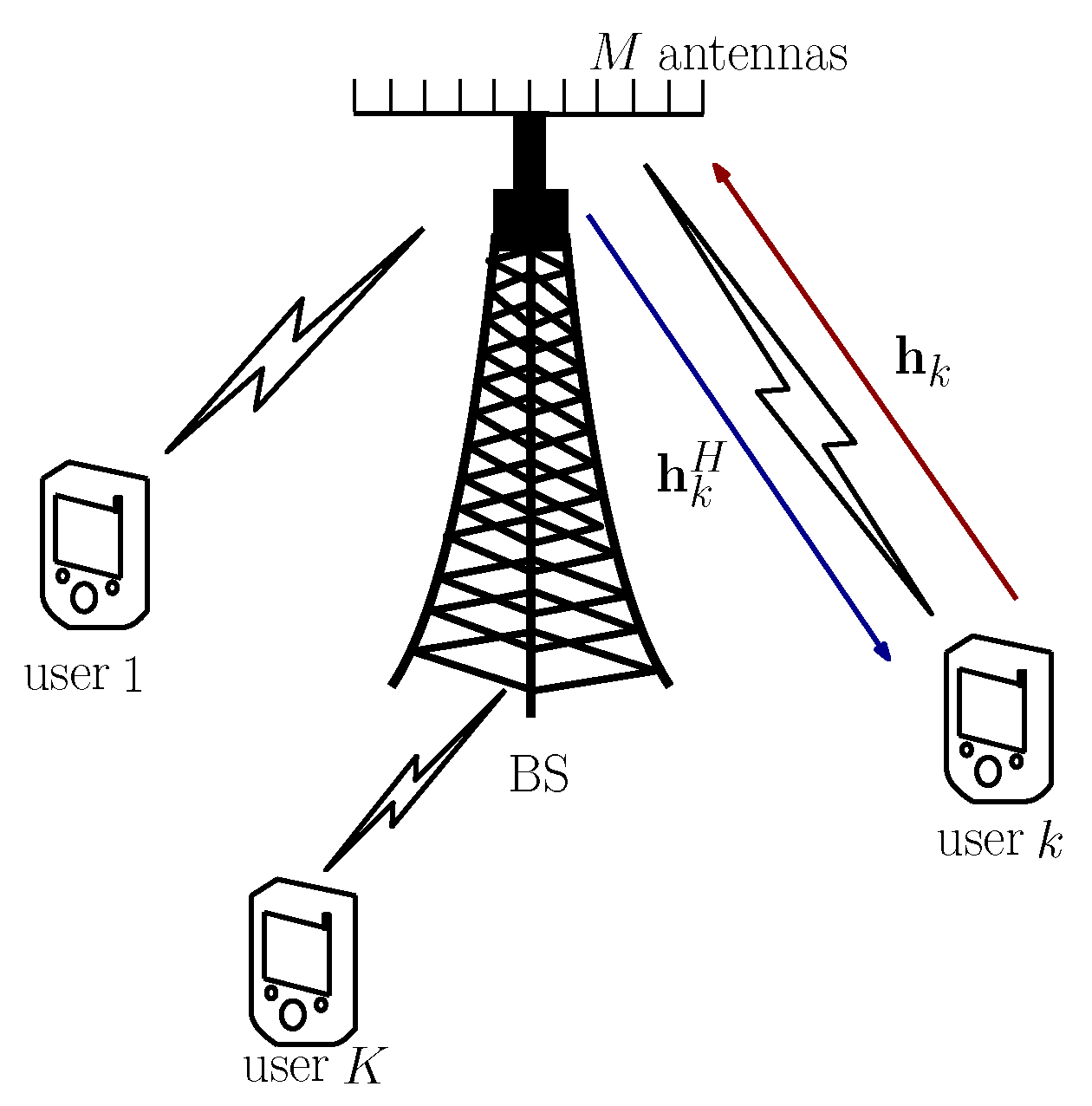

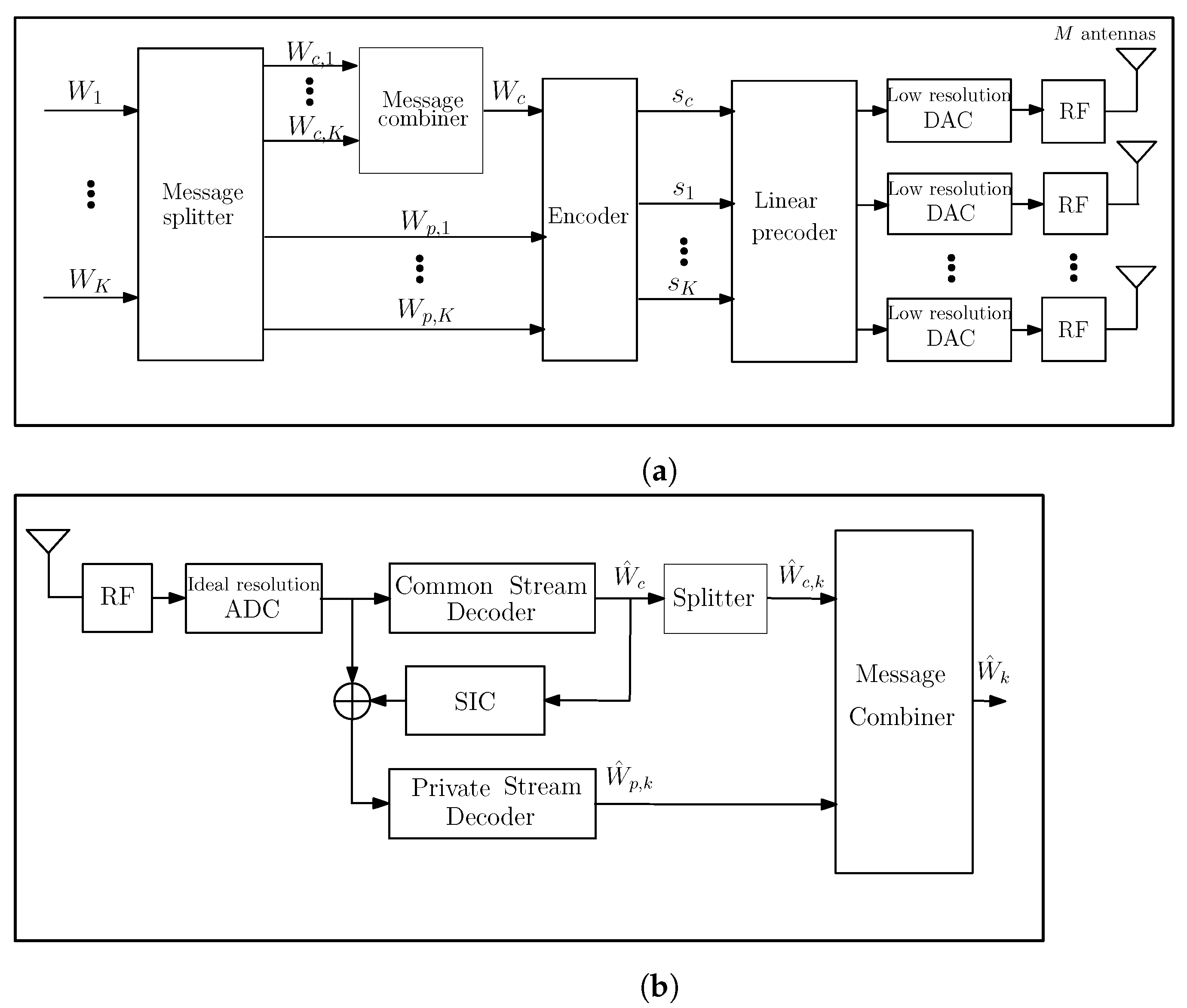



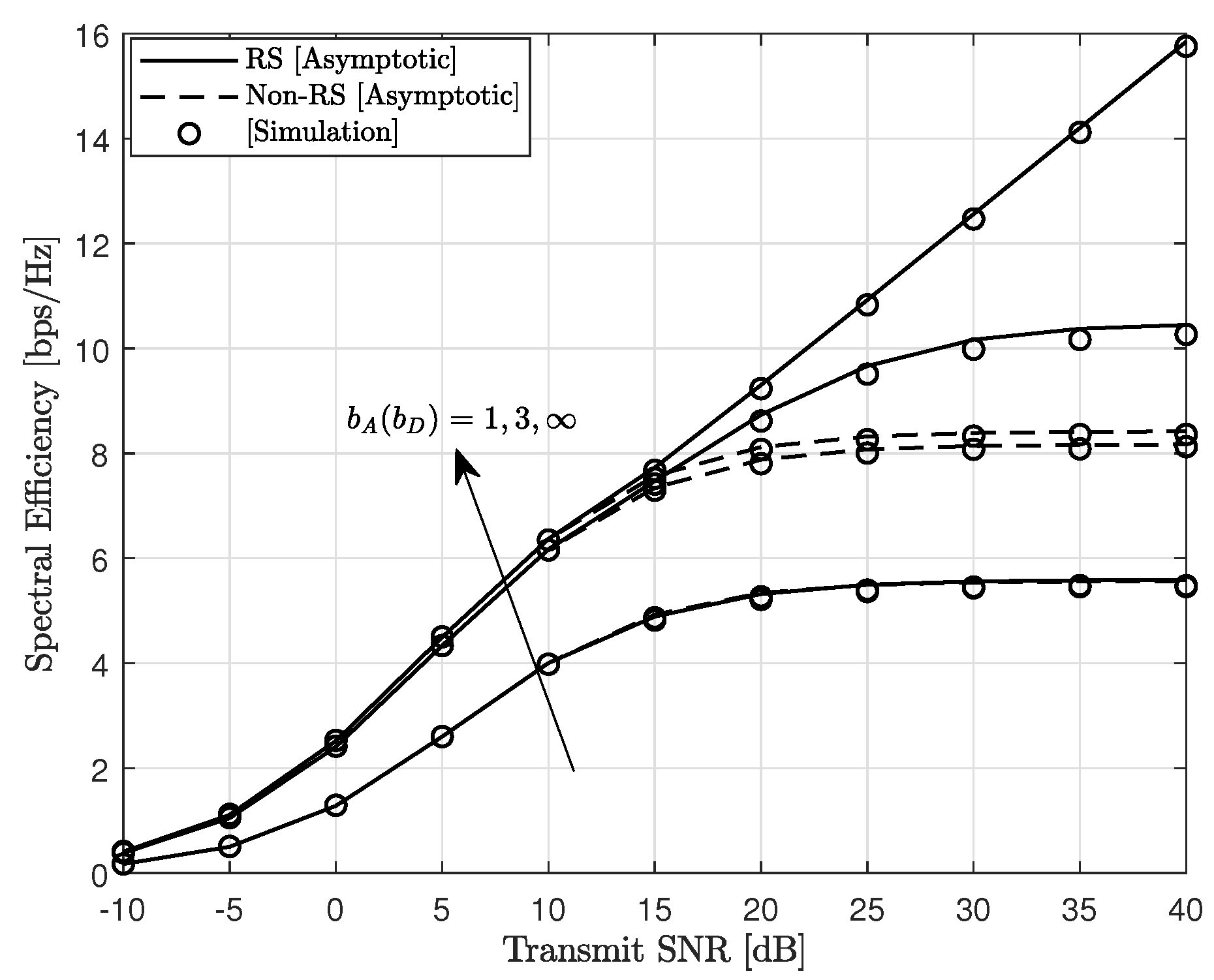
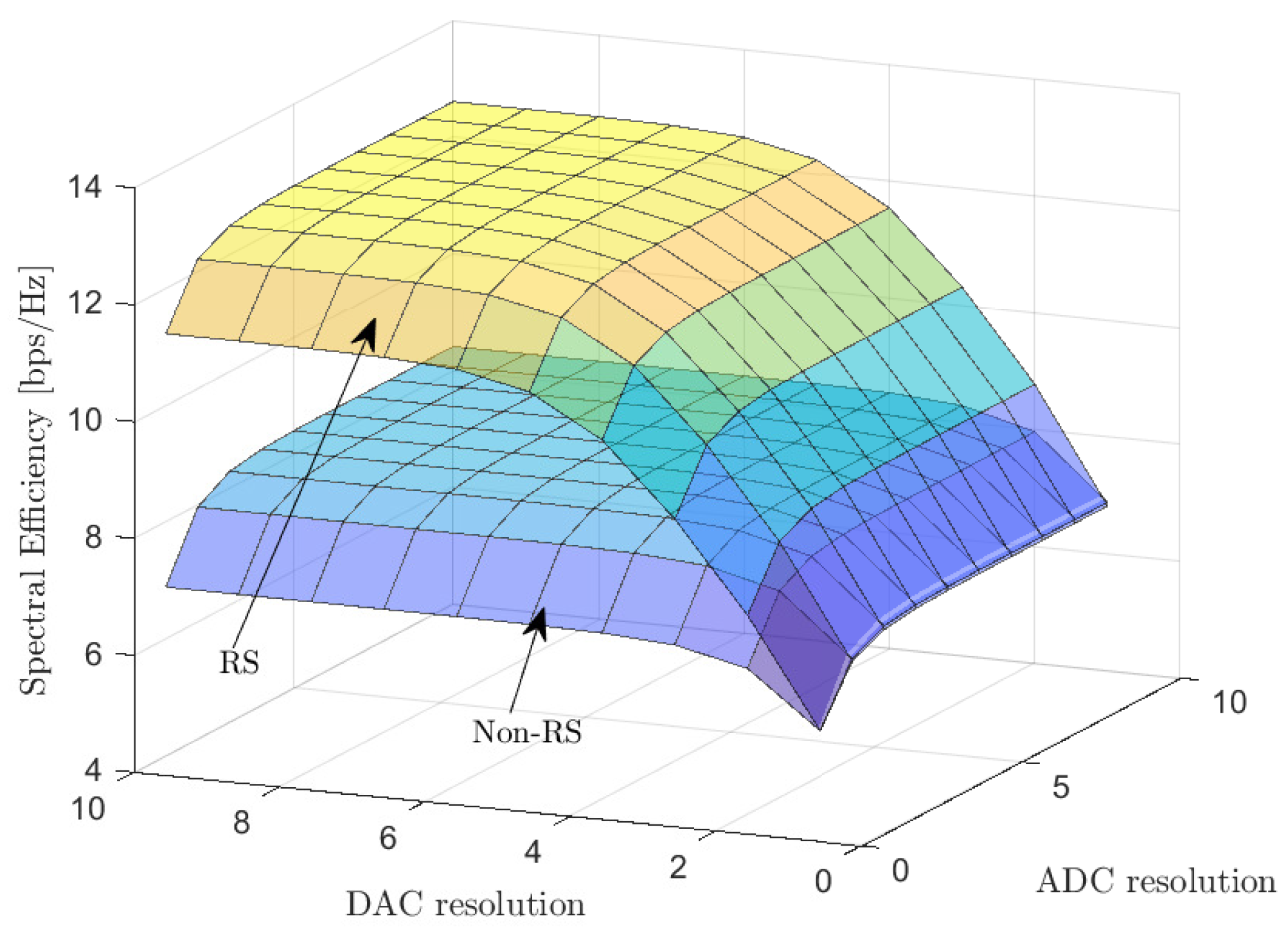
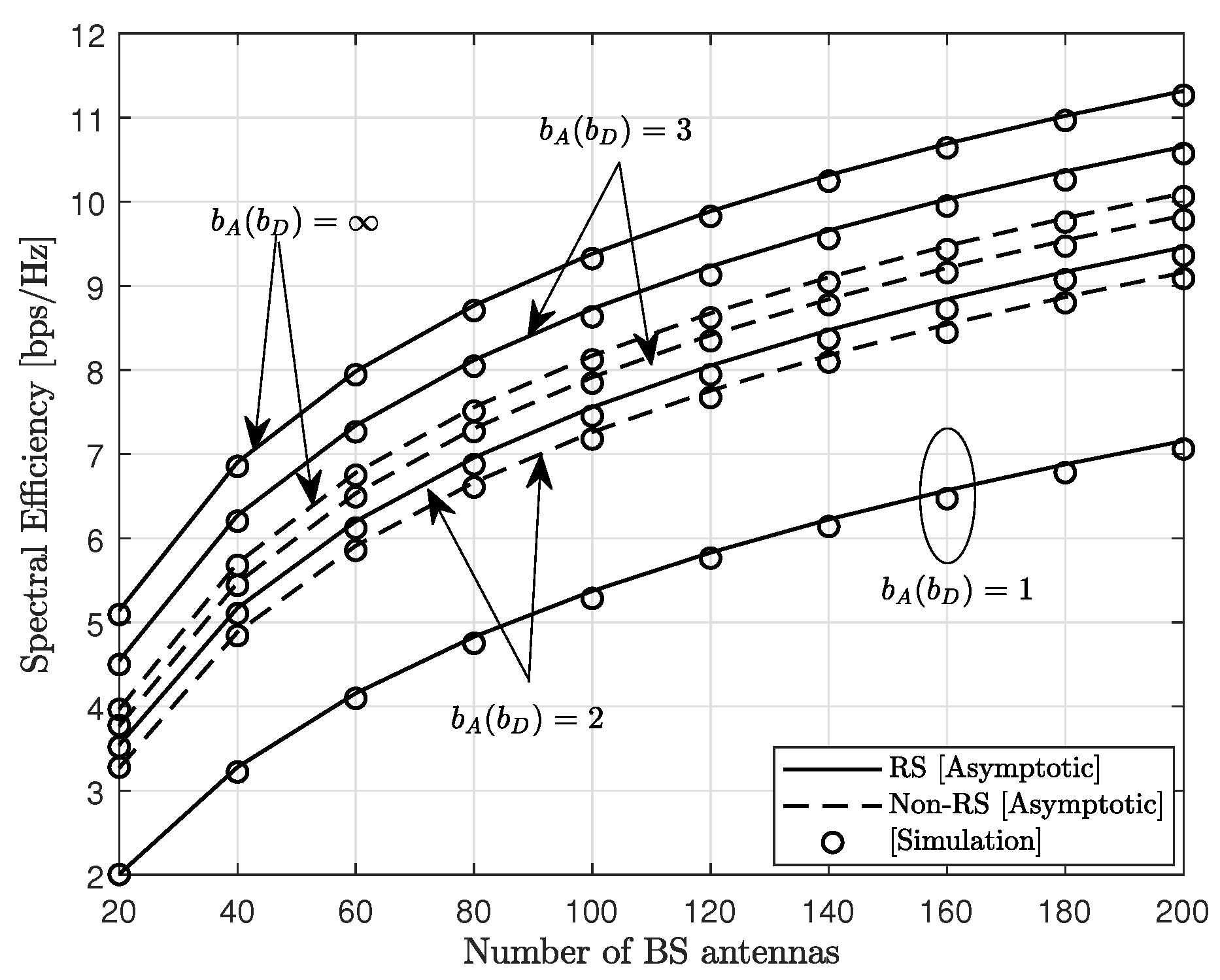

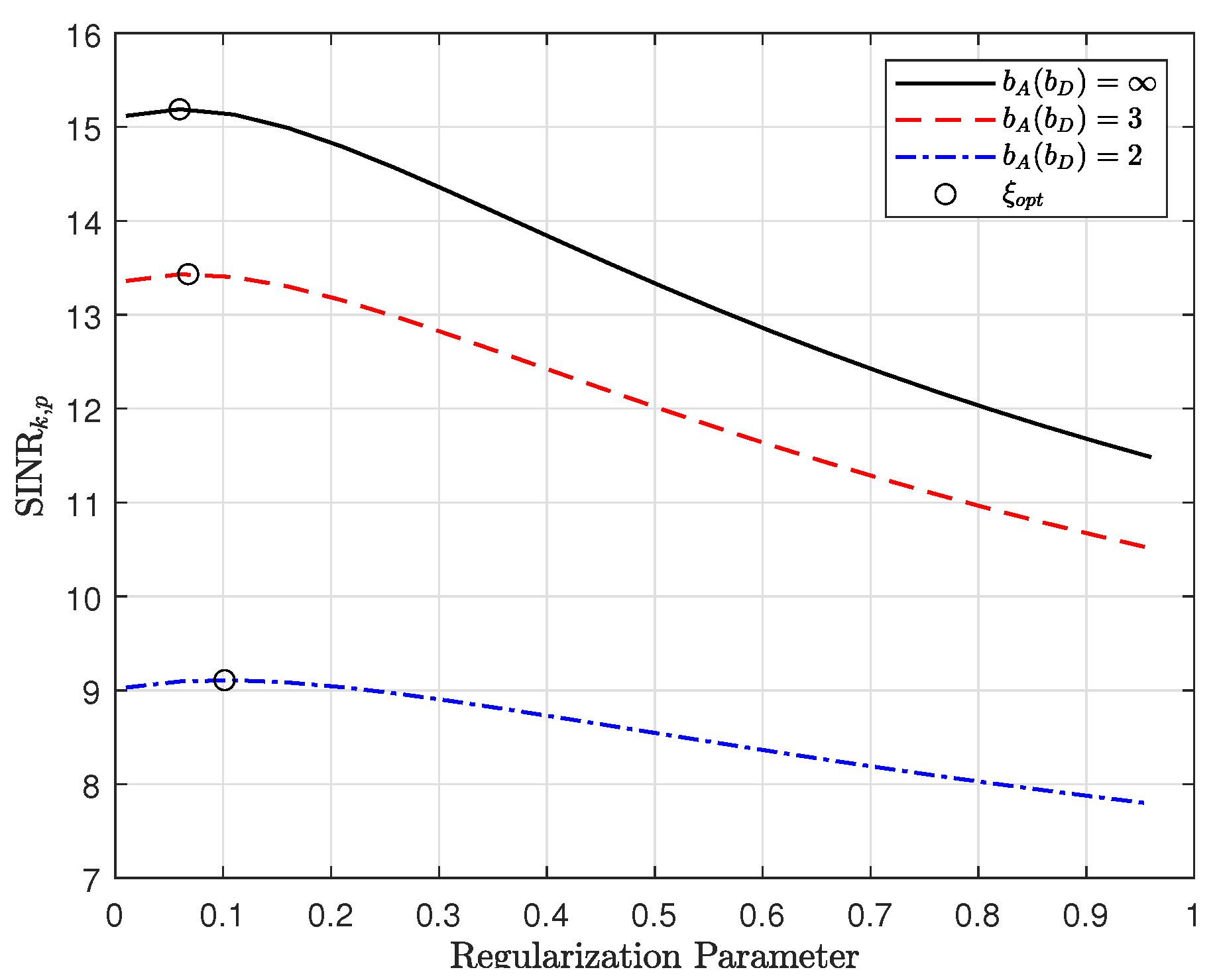
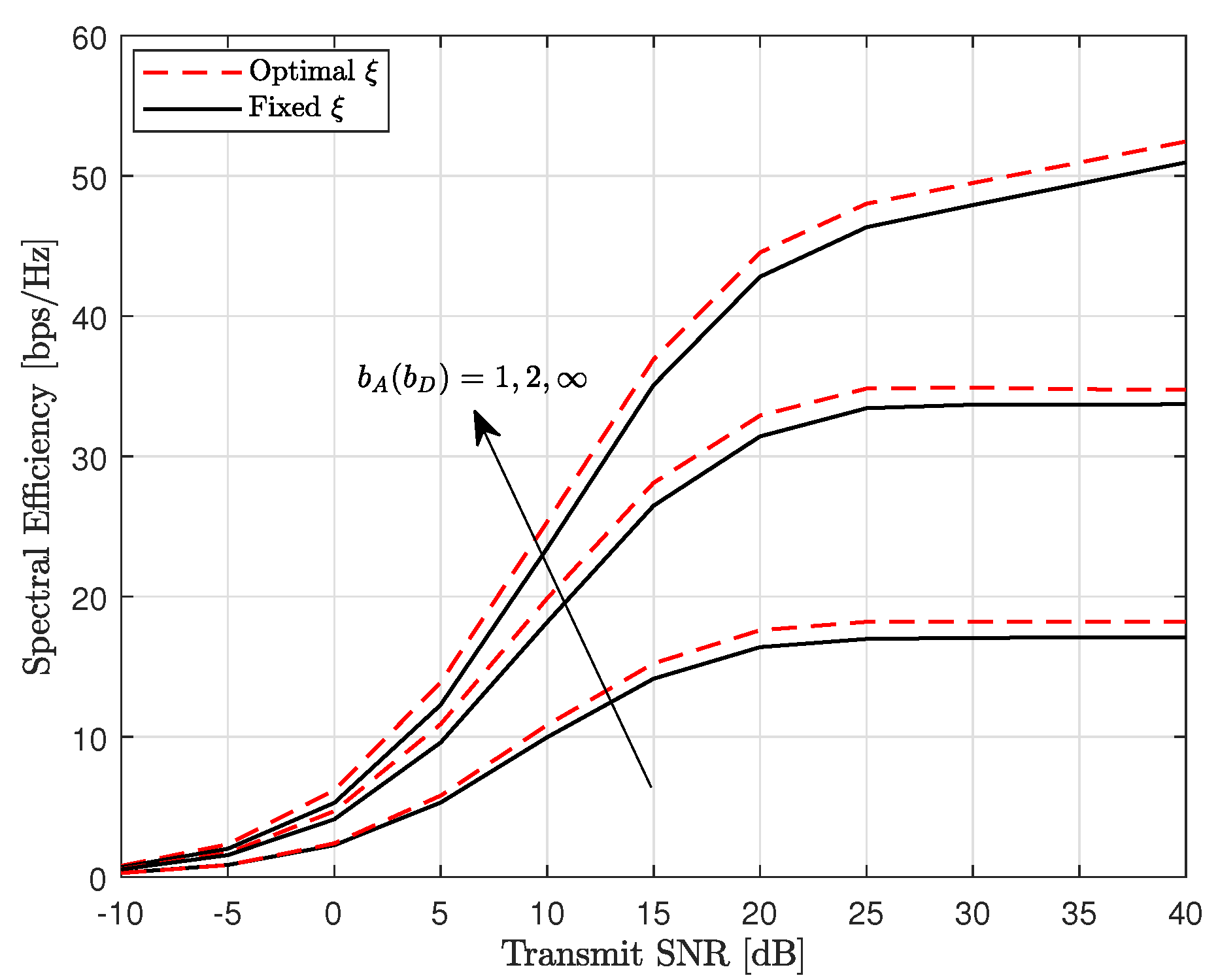
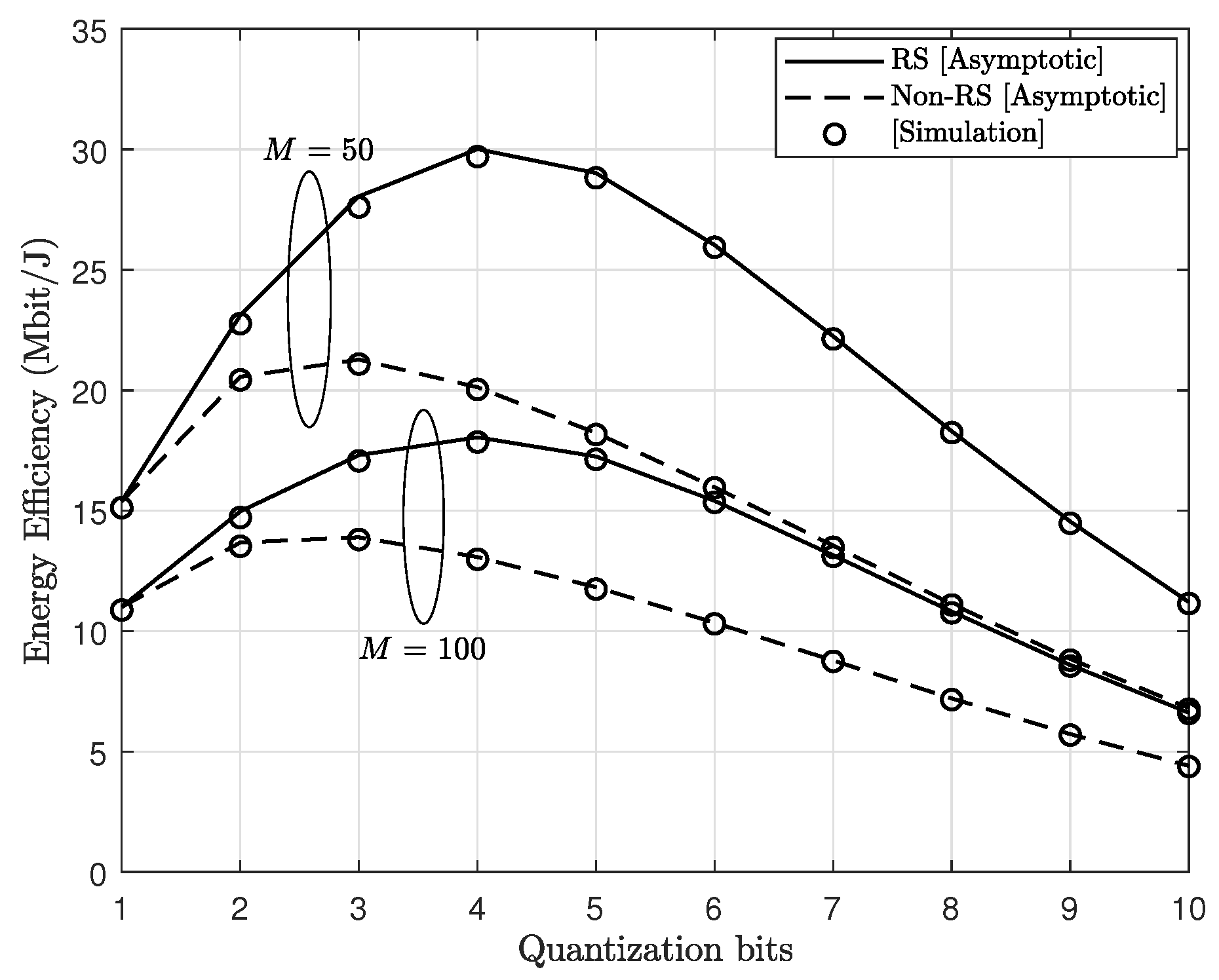

| Quantization Bits | SE [bps/Hz] | EE [Mbit/J] | ||
|---|---|---|---|---|
| RS | Non-RS | RS | Non-RS | |
| 1 | 5.55 | 5.55 | 11.01 | 11.01 |
| 2 | 8.22 | 7.52 | 14.95 | 13.68 |
| 3 | 10.13 | 8.14 | 17.27 | 13.90 |
| 4 | 11.48 | 8.33 | 18.01 | 13.06 |
| 5 | 12.21 | 8.38 | 17.22 | 11.82 |
| 6 | 12.48 | 8.40 | 15.38 | 10.35 |
| 7 | 12.56 | 8.40 | 13.13 | 8.78 |
| 8 | 12.58 | 8.40 | 10.79 | 7.21 |
| 9 | 12.59 | 8.41 | 8.58 | 5.72 |
| 10 | 12.59 | 8.41 | 6.60 | 4.41 |
Publisher’s Note: MDPI stays neutral with regard to jurisdictional claims in published maps and institutional affiliations. |
© 2021 by the authors. Licensee MDPI, Basel, Switzerland. This article is an open access article distributed under the terms and conditions of the Creative Commons Attribution (CC BY) license (https://creativecommons.org/licenses/by/4.0/).
Share and Cite
Ahiadormey, R.K.; Choi, K. Performance Analysis of Rate Splitting in Massive MIMO Systems with Low Resolution ADCs/DACs. Appl. Sci. 2021, 11, 9409. https://doi.org/10.3390/app11209409
Ahiadormey RK, Choi K. Performance Analysis of Rate Splitting in Massive MIMO Systems with Low Resolution ADCs/DACs. Applied Sciences. 2021; 11(20):9409. https://doi.org/10.3390/app11209409
Chicago/Turabian StyleAhiadormey, Roger Kwao, and Kwonhue Choi. 2021. "Performance Analysis of Rate Splitting in Massive MIMO Systems with Low Resolution ADCs/DACs" Applied Sciences 11, no. 20: 9409. https://doi.org/10.3390/app11209409
APA StyleAhiadormey, R. K., & Choi, K. (2021). Performance Analysis of Rate Splitting in Massive MIMO Systems with Low Resolution ADCs/DACs. Applied Sciences, 11(20), 9409. https://doi.org/10.3390/app11209409







